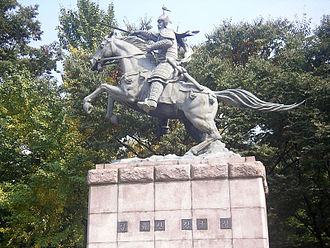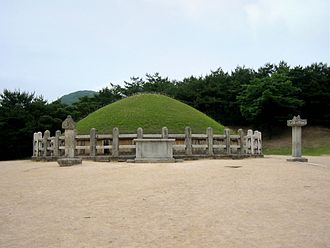kim_yushin__architect_of_korean_unification.wav
Kim Yushin (595-673) was a general in 7th-century Silla. He led the unification of the Korean peninsula by Silla under the reign of King Muyeol of Silla and King Munmu of Silla. He is said to have been the great-grandchild of King Guhae of Geumgwan Gaya, the last ruler of the Geumgwan Gaya state. This would have given him a very high position in the Silla bone rank system, which governed the political and military status that a person could attain.
Much of what we know about his life comes from the detailed account in the Samguk Sagi, Yeoljeon 1-3, and the much briefer record in the Samguk Yusa, vol. 1. Kim Yushin was the son of General Kim Seohyeon and Lady Manmyeong, who was a daughter of King Jinheung of Silla.
He was born in Gyeyang, Jincheon County in 595, became a Hwarang warrior at just 15 and was an accomplished swordsman and a Gukseon (, ; Hwarang leader) by the time he was 18 years old. By the age of 34 he had been given total command of the Silla armed forces. Kim's first military engagement in command is believed to have occurred around 629 AD, and through it he quickly proved his capabilities as a warrior.

Statue in Namsan Park, Seoul, South Korea
Throughout his life Kim Yusin had felt that Baekje, Goguryeo, and Silla should not be separate countries but united. He is regarded as the driving force in the unification of the Korean Peninsula, and is the most famous of all the generals in the unification wars of the Three Kingdoms.
Kim Yusin was rewarded handsomely for his efforts in the campaigns. In 668, King Munmu bestowed upon him the honorary title of Taedaegakgan (태대각간, 太大角干), something like "Grand Sub-Chief." He reportedly received a village of over 500 households, and in 669 was given some 142 separate horse farms, spread throughout the kingdom. He died four years later, leaving behind ten children.
Kim Yusin lived to the age of 79 and is considered to be one of the most
famous generals and masters of Korean swords in Korean history. He is the
focus of numerous stories and legends, and is familiar to most Koreans from
a very early age. Following his death in 673, General Kim was awarded the
honorary title of King Heungmu.
Kim Yusin
Samguk Sagi contains a full three volumes of biografical stories of the
distuinguished Silla General, much more than on anyone else.
See Vos, Frits: Kim Yusin, Persönlichkeit und Mythos: Ein Beitrag zur
Kenntnis der Altkoreanischen Geschichte, Oriens Extremus 1 (1954) p.29-70
and 2 (1955) p.210-236 for a full translation of all material of Kim Yushin
from both the Sagi and Yusa (in German).
Kim Yusin was 15 when he became a Hwarang and 18 when he became Master of
the sword and a Kuksón. By the time of his death he was one of the most
powerful men in Korea and was buried like a king.
He was born in 595, and became the leader of a Hwarang group called
Yonghwa-Hyangdo "Band of the Dragon Flower Tree" (= the Nagavrksa tree; the
Bodhi tree under which Maitreya Buddha would rise and teach his learning).
From King Húngdók (826-836) Kim Yusin was later awarded the posthumous title
of "Great King Húngmu" (Húngmu Taewang - great king promoting the martial
arts).

Portrait of Gim Yu-sin
in the "famous portrait photo book of Joseon" published in 1926

Tomb of General Kim Yu-sin in Gyeongju
Royal Tomb of King Taejong Muyeol
(Tomb of Kim Yu-shin)